![]()
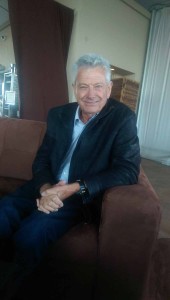
Seale, in semi-retirement, got a request from director George Miller asking if he would take on the job of cinematographer. At the time he was about to embark on a long-planned trip to the Great Barrier Reef on his sailing yacht. “I retire after every picture,” he said joshingly in a recent interview with Below the Line. “He called me and gave me overnight to think about it and I enthusiastically said yes the next morning,” he recalled. “After all it was George, whom I had worked with so creatively on Lorenzo’s Oil, and it was another Mad Max film.”
Mad Max: Fury Road is not so much a sequel to the three Mad Max films that preceded it as it is an imaginative reinvention of the post-apocalyptic series. The film stars Tom Hardy as the iconic anti-hero Max Rockatansky and Charlize Theron as the one-armed Imperator Furioso, adding a feminist element to the plot.
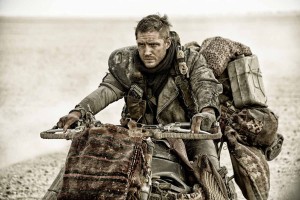
Seale didn’t quite anticipate just how arduous and complicated the job would turn out to eventually be. “But I had a reasonable idea, because in the ten years of prep that had gone on for the film, I had heard through the grapevine in Sydney that it would be a massive production with lots of stunts and they were building special cameras for the shoot, “he recalled. ‘’’My God,’ I thought, that sounds awesomely challenging, and I missed that kind of filmmaking.”
And there were challenges galore. “I was walking into a minefield of new technology,” he noted. “I hadn’t shot digitally or 3D before. Suddenly I was in the middle of it, and had to learn an awful lot very quickly.” Fortuitously, Miller decided at the last minute to drop the 3D idea and shoot in conventional 2D instead, learning that recent developments made it easier to convert to 3D in post-production. “George came in on a Monday to a meeting of everyone involved in Fury Road, and said no 3D,” he recalled. “It floored everyone.” But it made Seale’s learning curve less steep.
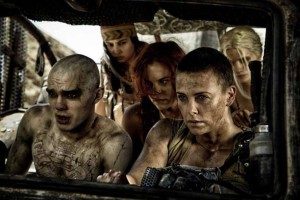 For his digital camera he chose the current favorite of many cinematographers, the Arri Alexa. “I knew it was being used by a lot of the boys around the world,” he said. “It was battle-tested, had been used in desert and arctic situations, and could handle the rigors of location shooting.”
For his digital camera he chose the current favorite of many cinematographers, the Arri Alexa. “I knew it was being used by a lot of the boys around the world,” he said. “It was battle-tested, had been used in desert and arctic situations, and could handle the rigors of location shooting.”
Miller wanted Fury Road to be shot on a single camera but Seale convinced him to use a number of cameras. “George had a theory of one camera covering the whole thing,” said the DP. “I like to use multiple cameras and after we talked about it, he said if you think you can make it work, please do.” Later in the editing room he was happy to have all the cutaways. “You can throw footage on the floor if you don’t want it, but you can’t use it if you don’t have it.”
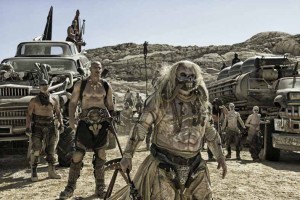 There would wind up being many, many cameras. By the time principle photography was underway, Seale and his team would have an average of three to four Arri Alexa Plus cameras and two to four Arri M Steadicams running simultaneously each day, plus aerials. Meanwhile, Canon-5D’s were used as crash-cams with retrievable digital cards. Seale also volunteered to operate his own camera, capturing the imagery through an 11:1 zoom lens. “I love to get out there and get little close-ups,” Seale said.
There would wind up being many, many cameras. By the time principle photography was underway, Seale and his team would have an average of three to four Arri Alexa Plus cameras and two to four Arri M Steadicams running simultaneously each day, plus aerials. Meanwhile, Canon-5D’s were used as crash-cams with retrievable digital cards. Seale also volunteered to operate his own camera, capturing the imagery through an 11:1 zoom lens. “I love to get out there and get little close-ups,” Seale said.
About 40 percent of the film takes place in the cabin of the Big Rig, driven by Imperator Furiosa. The DP used the same set of Alexa minis that DP Roger Deakins employed on his James Bond movie Skyfall. “Panavision built special lenses so whenever we shot in the truck we didn’t have to worry about focus.”
Another innovation was the use of the Edge Arm system, a gyro-stabilized camera crane that was mounted on the roof of supercharged V-8 off-road racing truck. It was able to extend up to 20 feet, rotate 360-degrees, and achieve a full range of motion in any direction. A safely attached camera delivered remarkable shots. “We had one shot that started with a close-up of the driver of the truck, swung back and lifted until you could see the whole armada of vehicles, all done very smoothly,” said Seale. “The first Edge was so good, that we got a second one,” he noted. Guy Norris, the second unit director used the Edge for many of the eye-popping stunt sequences. “Sometimes we used both of them together,” said the DP.
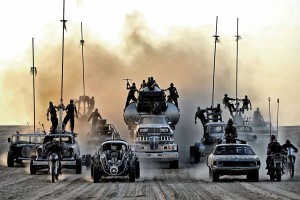 Miller has one strong preference: cameras should always center on the most important element in the frame. Following this rule makes cutting the film easier, especially in the super-fast edits Miller goes for. There are 2700 edits in the 108-minute, each averaging less than 3 seconds.
Miller has one strong preference: cameras should always center on the most important element in the frame. Following this rule makes cutting the film easier, especially in the super-fast edits Miller goes for. There are 2700 edits in the 108-minute, each averaging less than 3 seconds.
“We had three operators and sometimes four, and the principle point of each shot was always to center frame,” said Seale. “It was very hard for us, because we all been brought up on a tradition of image making that likes to utilize the entire frame.” Miller asked for all those fast edits to maintain the pace of the film, “and he didn’t want the audience to search the frame a lot for the point of interest of the shot, so we center framed a lot.”
Seale is a member of both the American Society of Cinematographers and the Australian Cinematographers Society. Over his long career he has lensed many notable films including the aforementioned The English Patient, which got him an Oscar and a BAFTA; Cold Mountain, Harry Potter and the Sorcerer’s Stone, The Talented Mr. Ripley and Rain Man.
Is he ready to do another film after his adventures with Miller on Mad Max: Fury Road? “I’m pulling back a bit, my wife has put up with a lot over the years, I have five 5 grandchildren and I want to do a lot of sailing and fishing,” said Seale, who is 73. “But If one fits into my plans, I’ll do it.”





